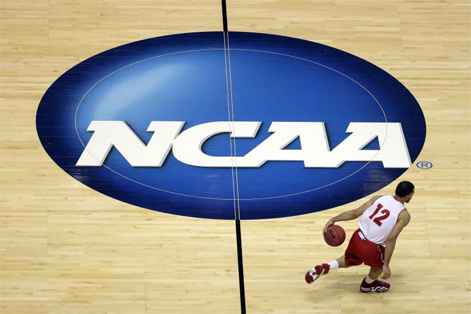|
|
|
|
|
|
 |
|
|
Starting
this
fall,
NCAA
Division
I
schools
will be
able to
pay
players
directly
up to a
salary
cap of
$20.5
million.
(Jae C.
Hong/AP) |
| |
College
Sports
Enter
New Era
as
Schools
Begin
Direct
Payments
to
Athletes
Historic
$2.8
billion
settlement
ends
century-old
amateur
model
Justin
Tyme -
Sports
Dustin
Schoenherr
- Sports
Tell Us
USA News
Network
DETROIT
- For
the
first
time in
NCAA
history,
college
athletes
across
the
country
are now
eligible
to
receive
direct
payments
from
their
schools,
marking
the end
of the
traditional
amateur
model
that has
defined
college
sports
for over
a
century.
The
transformation
began
July 1,
following
federal
court
approval
of a
landmark
$2.8
billion
legal
settlement
that
resolved
years of
litigation
challenging
the
NCAA's
restrictions
on
athlete
compensation.
Schools
can now
distribute
up to
$20.5
million
annually
to their
student-athletes
through
a new
revenue-sharing
system.
"This is
the most
significant
change
in
college
athletics
in our
lifetime,"
said
Mark
Thompson,
athletic
director
at State
University,
whose
program
announced
it would
pay out
the full
allowable
amount.
"We're
entering
completely
uncharted
territory."
The
settlement,
approved
by a
federal
judge on
June 6,
stems
from the
House v.
NCAA
class-action
lawsuit
that
argued
the
organization's
compensation
restrictions
violated
antitrust
laws.
Under
the
agreement,
the NCAA
and
participating
schools
will pay
$2.75
billion
to
former
college
athletes
who
competed
before
2021,
when
name,
image,
and
likeness
(NIL)
rules
first
allowed
athletes
to earn
endorsement
money.
Major
Conferences
Commit
Full
Funding
Schools
in the
Big 12,
Big Ten,
and SEC
have all
confirmed
they
will
distribute
the
maximum
$20.5
million
available
for the
2025-26
academic
year.
The
payment
cap
increases
annually
throughout
the
10-year
agreement,
reaching
a
projected
$32.9
million
by
2034-35.
"Our
commitment
is to
provide
every
opportunity
for our
student-athletes
to
benefit
from
this new
landscape,"
said
Sarah
Martinez,
commissioner
of the
Atlantic
Coast
Conference.
"This
represents
a
fundamental
shift in
how we
support
our
athletes."
The
payments
are not
mandatory,
allowing
schools
discretion
in
determining
how much
to
distribute
and
which
athletes
receive
compensation.
However,
early
indications
suggest
most
major
programs
plan to
utilize
the full
allowable
amount
to
remain
competitive
in
recruiting.
Implementation
Challenges
The
rollout
has
required
significant
administrative
adjustments.
All
participating
institutions
must use
the
newly
implemented
College
Athletics
Payment
System
(CAPS)
to
allocate
funds,
monitor
payments,
and
ensure
compliance
with
roster-based
regulations.
Athletes
receiving
direct
payments
face new
tax
obligations,
with
revenue
sharing
treated
as
self-employment
income
and
reported
via Form
1099-MISC.
Many
programs
are
providing
financial
literacy
education
to help
athletes
navigate
these
responsibilities.
"We're
not just
changing
how we
pay
athletes,
we're
changing
how we
educate
them
about
money
management
and
taxes,"
explained
Dr.
Jennifer
Walsh,
compliance
director
at
Midwest
University.
"It's a
complete
paradigm
shift."
Industry
Transformation
The move
represents
the
culmination
of
mounting
pressure
on the
NCAA's
amateur
model,
which
faced
increasing
legal
challenges
and
criticism
from
athletes'
rights
advocates.
The
settlement
comes as
college
sports
generate
billions
in
revenue
through
television
contracts,
ticket
sales,
and
merchandise.
Student-athletes
have
long
argued
they
deserved
a share
of the
profits
generated
by their
athletic
performances,
particularly
as
coaches
and
administrators
earned
substantial
salaries.
The new
system
acknowledges
their
contribution
to the
enterprise
while
maintaining
their
status
as
students.
"This is
about
fairness
and
recognizing
the
value
these
athletes
bring to
their
institutions,"
said
Michael
Rodriguez,
executive
director
of the
College
Athletes
Rights
Coalition.
"It's
long
overdue."
Looking
Forward
As the
first
week of
direct
payments
concludes,
athletic
departments
are
closely
monitoring
the
impact
on
recruiting,
team
dynamics,
and
competitive
balance.
The NCAA
continues
to work
with
schools
on
implementation
guidelines
and
compliance
standards.
The
settlement
also
includes
provisions
for
ongoing
oversight
and
potential
adjustments
as the
system
evolves.
Industry
observers
expect
continued
refinement
of the
revenue-sharing
model as
both
schools
and
athletes
adapt to
this new
reality.
For
current
college
athletes
like
University
of
Michigan
basketball
player
Alex
Johnson,
the
change
represents
both
opportunity
and
responsibility.
"It's
exciting
to be
part of
this
historic
moment,"
Johnson
said.
"We
understand
we're
setting
the
precedent
for
future
generations
of
student-athletes."
The
transformation
of
college
athletics
continues
to
unfold
as
schools,
athletes,
and fans
adjust
to a
landscape
where
the
century-old
principle
of
amateurism
has
given
way to
direct
compensation
for
on-field
performance.
Additional
reporting
contributed
by staff
writers.
|
|
|
|
|
|
|
|
|